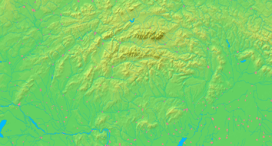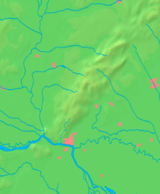Senec, Slovakia
| Senec Szenc | ||
| Town | ||
 Town centre of Senec | ||
|
||
| Country | Slovakia | |
|---|---|---|
| Region | Bratislava | |
| District | Senec | |
| Elevation | 137 m (449 ft) | |
| Coordinates | SK 48°13′08″N 17°23′59″E / 48.21889°N 17.39972°ECoordinates: SK 48°13′08″N 17°23′59″E / 48.21889°N 17.39972°E | |
| Area | 38.714 km2 (14.948 sq mi) | |
| Population | 18,208 (2014-12-31) | |
| Density | 470/km2 (1,217/sq mi) | |
| First mentioned | 1252 | |
| Mayor | Karol Kvál | |
| Timezone | CET (UTC+1) | |
| - summer (DST) | CEST (UTC+2) | |
| Postal code | 903 01 | |
| Area code | +421-2 | |
| Car plate | SC | |
  Location in Slovakia | ||
  Location in the Bratislava Region | ||
| Wikimedia Commons: Senec | ||
| Statistics: MOŠ/MIS | ||
| Website: www.senec.eu | ||
Senec is a town in the Bratislava Region of south-western Slovakia. It is a well known summer tourism and recreation center. The town is attractive not only because of the proximity of Bratislava, the capital of Slovakia, but also because of the healthy environment and summer resort "Slnečné jazerá" ("Sunny Lakes").
Name
The town was first mentioned in 1252 as "Synci". The contemporary name Senec, used since the first half of the 20th century, is derived from the historic names Zemch and Szempcz. A German historic name was Wartberg.
History
In the 9th century, the territory of Senec became part of the Kingdom of Hungary. In the second half of the 15th century, Hungarian king Matthias Corvinus gave Senec privileges and it got the right of organizing a fair around 1480. In the 19th century, it started to develop after the Pressburg - Budapest railway which runs through the town had been built. After the Austro-Hungarian army disintegrated in November 1918, Czechoslovak troops occupied the area, later acknowledged internationally by the Treaty of Trianon. Between 1938 and 1945 Senec once more became part of Miklós Horthy's Hungary through the First Vienna Award. In 1945, it was recovered by Czechoslovakia. A number of residents were affected by the Benes Decrees and 630 rich and intellectual citizens of Hungarian nationality of Senec were forced to leave the town in 1947 to Hungary. This was a part of ethnic cleansing in Czechoslovakia.[1] From 1945 until the Velvet Divorce, it was part of Czechoslovakia. Since then it has been part of Slovakia.
The historic Church of Saint Nicholaus is located in the southwestern part of the town.
Geography

Senec is situated in Podunajská nížina, on the boundary line of Podunajská rovina and Podunajská pahorkatina. The town is 27 km far from the Austrian boundary (frontier crossing at Kittsee), and 28 km far from the border with Hungary (frontier crossing at Rajka). Vienna (90 km), Budapest (230 km) and Prague (350 km) are the nearest European capitals.[2]
The town is located 25 kilometres north-east from Bratislava, 126 m above sea level. It has good access to the motorway D1 from Bratislava to Žilina, and is situated on the significant 4th Corridor of Trans-European Transport Network - Railway route Prague - Bratislava - Balkans/Orient.[2]
The town consists of four boroughs (Senec, Svätý Martin, Červený majer and Horný dvor).
Demographics
In 2001 14,673 permanent residents lived in Senec and the population density was 379/km². Accordingly, Senec ranks at the 55th place among 138 Slovak cities and towns. Following the age, 67.5% inhabitants are in the productive age (men 15–59 years old, women 15–54 years old). 77% occupants acknowledged Slovak nationality and 22% Hungarian nationality. The Roman Catholic Church dominates with 71.7% within the religious structure. The Protestant Church with 8.45% is the second largest Church. The residents without faith represent 12.89%. In education, technical and secondary schools without the General Certificate of Education dominate with 27.91%. In 2001 graduates represented 11.17% share of Senec residents.[2]
International relations
Twin towns — Sister cities
Senec, Slovakia is twinned with:
See also
References
- ↑ Popély Árpád: Lakosságcsere és reszlovakizáció, 2002, page 471
- 1 2 3 http://www.senec.sk/index.php?id=106&lang=1 (Slovak)
